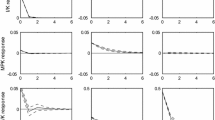Abstract
In recent years, several studies have attempted to explain the positive link between corporate investment and internal cash flows by hypothesizing the existence of asymmetric information. Managers know that the firm has high return investment opportinities, but the capital market does not. An alternative explanation for cash flow's relationship to investment is that managers have the discretion to use the company's cash flows to advance their own interests, and these are positively linked to the growth of the firm. The asymmetric information hypothesis predicts a positive relationship between investment and cash flow for firms with returns on investment above their costs of capital, the managerial discretion hypothesis predicts a positive relationship for firms with returns below their costs of capital. This paper presents evidence consistent with both hypotheses.
Similar content being viewed by others
References
Baumol, W.J., Heim, P., Malkiel, B.G., and Quandt, R.E. (1970), ‘Earnings Retention, New Capital and the Growth of the Firm’,Review of Economics and Statistics 52, 345–55.
Baumol, W.J., Heim, P., Malkiel, B.G., and Quandt, R.E. (1973) ‘Efficiency of Corporate Investment: Repiy’,Review of Economics and Statistics 55, 128–131.
Becchetti, L. (1995) ‘Finance, Investment and Innovation: A Theoretical and Empirical Analysis’,Empirica 22, this issue.
black, E. and Scholes, M. (1974), ‘The Effects of Dividend Yield and Dividend Policy on Common Stock Prices and Returns’,Journal of Financial Economics 1, 1–22.
Blume, M.E. (1980), ‘Stock Returns and Dividend Yields: Some More Evidence’,Review of Economics and Statistics 62, 567–77.
Brittain, J.A. (1966)Corporate Dividend Policy, Washington: The Brookings Institution.
Corpenter, R. (1995) ‘Finance Constraints or Free Cash Flow? A New Look at the Life Cycle Model of the Firm’,Empirica 22 this issue.
Duesenberry, J.S. (1958)Business Cycles and Economic Growth, New York: McGraw-Hill.
Fazzari, S., Hubbard, R.G., and Petersen, B. (1988), ‘Financing Constraints and Corporate Investment’,Brookings Papers on Economic Activity 1, 141–95.
Fazzari, S.M. and Petersen, B.C. (1993), ‘Working Capital and Fixed Investment: New Evidence on Financing Constraints’,The RAND Journal of Economics 24, 328–42.
Friend, I. and Puckett, M. (1964) ‘Dividends and Stock Prices,’American Econoomic Review 54, 656–82.
Grabowski, H.G. and Mueller, D.C. (1972), ‘Managerial and Stockholder Welfare Models of Firm Expenditures,’Review of Economics and Statistics 54, 9–24.
Grabowski, H.G. and Mueller, D.C. (1975), ‘Life-cycle effects on Corporate Returns on Retentions’Review of Economics and Statistics 57, 400–9.
Graham, B. and Dodd, D.L. (1951)Security Analysis. New York: McGraw-Hill.
Hoshi, T., Kashyap, A., and Scharfstein, D. (1991), ‘Corporate Structure, Liquidity, and Investment: Evidence from Japanese Industrial Groups’,Quarterly Journal of Economics 106, 33–60.
Kato, T. (1995), ‘Chie Executive Compensation and Corporate Groups in Japan: New Evidence from Micro Data’,International Journal of Industrial Organization (forthcoming),
Kuh, E. (1963)Capital Stock Growth: A Micro-Economic Approach, Amsterdam: North Holland,
Lang, L.H.P. and Litzenberger, R.H. (1989) ‘Dividend Announcements’,Journal of Financial Economics 24, 181–91.
Lintner, J. (1956) ‘Distribution of Income of Corporations Among Dividends, Retained Earnings and Taxes’,American Economic Review 46, 97–113.
Marris, R. (1964)The Economic Theory of Managerial Capitalism, Glencoe: Free Press.
Meyer, J.R. and Glauber, R.R. (1964)Investment Decisions, Economic Forecasting, and Public Policy. Cambridge, MA: Harvard University Press.
Meyer, J.R. and Kuh, E. (1957)The Investment Decision, Cambridge, MA: Harvard University Press.
Modigliani, F. and Miller, M.H. (1958) ‘The Cost of Capital, Corporation Finance and the Theory of Investment’,American Economic Review 48, 261–97.
Mueller, D.C. (1969) ‘A Theory of Conglomerate Mergers’,Quarterly Journal of Economics 83, 643–59.
Mueller, D.C. (1972) ‘A Life Cycle Theory of the Firm’,Journal of Industrial Economics 20, 199–219.
Mueller, D.C. and Reardon, E.A. (1993) ‘Rates of Return on Corporate Investment’,Southern Economic Journal 60, 430–53.
Mueller, D.C. and Yun, L. (1995) ‘Rates of Return Over the Firm's Life Cycle’, mimeo, University of Vienna.
Myers, S.C. and Majluf, N.S. (1984) ‘Corporate Financing and Investment Decisions When Firms Have Information that Investors Do Not’,Journal of Financial Economics 13, 187–221.
Oliner, S.D. and Rudebusch, G.D. (1992) ‘Sources of the Financing Hiararchy for Business Investment’,Review of Economics and Statistics 74, 643–54.
Scott, J.T. and Pascoe, G. (1984), ‘Capital Costs and Profitability’,International Journal of Industrial Organization 2, 217–33.
Shinnar, R., Dressler, O., Feng, C.A., and Avidan, A.I. (1989) ‘Estimation of the Economic Rate of Return for Industrial Companies’,Journal of Business 62, 417–45.
Singh, A. (1994). ‘How Do Large Corporations in Developing Countries Finance Their Growth?’,Finance and the International Economy 8, 121–41.
Vogt, S.C. (1994) ‘The Cash Flow/Investment Relationship: Evidence from U.S. Manufacturing Firms’,Financial Management 23, 3–20.
Author information
Authors and Affiliations
Rights and permissions
About this article
Cite this article
Kathuria, R., Mueller, D.C. Investment and cash flow: Asymmetric information or managerial discretion. Empirica 22, 211–234 (1995). https://doi.org/10.1007/BF01384151
Issue Date:
DOI: https://doi.org/10.1007/BF01384151



